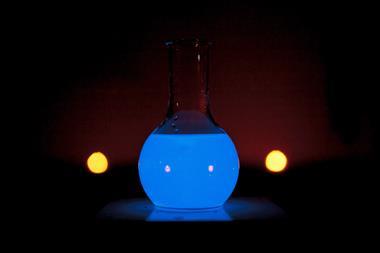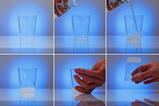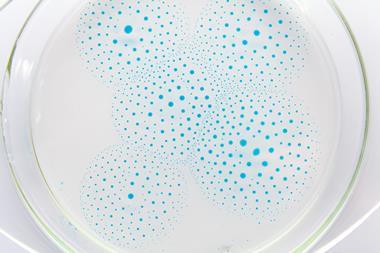Watch the video and download technician notes from the Education in Chemistry website: rsc.li/EiC418ec
The catalytic decomposition of hydrogen peroxide provides teachers with a whole range of exciting demonstrations. While ‘elephant’s toothpaste’ may be the most popular, there are plenty of alternatives you can use to keep things fresh. For example, the changing colour of the cobalt chloride ‘traffic light’ demonstration highlights the temporary shift in oxidation state of a transition metal catalyst.
The catalytic decomposition of hydrogen peroxide provides teachers with a whole range of exciting demonstrations. While ‘elephant’s toothpaste’ (rsc.li/Gh76klm) may be the most popular, there are plenty of alternatives you can use to keep things fresh. For example, the changing colour of the cobalt chloride ‘traffic light’ demonstration highlights the temporary shift in oxidation state of a transition metal catalyst (rsc.li/2sOacQP).
An often-overlooked demonstration with a sense of magic and wonder is the ‘genie in the bottle’, in which a puff of ‘smoke’ escapes from a bottle when the lid is removed.
Kit
- 25 cm3 hydrogen peroxide, 100 vol (30%), (harmful, risk of serious damage to eyes)
- c.0.5 g manganese(IV) oxide (harmful by inhalation and ingestion)
- 250 cm3 borosilicate conical flask with a narrow neck (30–40 mm), or poly(ethylene terephthalate) (PET) carbonated drinks bottle
- Bung with a hole bored through it
- Filter funnel
- Tissue paper
- Cotton thread
Preparation
Work in a well-ventilated room, wearing splash-proof goggles and gloves. Using a filter funnel, pour 25 cm3 of 100 vol hydrogen peroxide into the bottom of a 250 cm3 borosilicate conical flask, ensuring the liquid does not touch the sides of the flask.
Cut an 8 cm square of tissue paper. Weigh out approximately 0.5 g of manganese(IV) oxide into the tissue paper. Fold up the corners to make a pouch and tie it off with the cotton thread. Leave at least 10 cm of thread loose to suspend the pouch.
Lower the pouch carefully into the flask so that it is suspended above, but well clear of, the liquid beneath, and hold it in place by inserting the bung. The hole in the bung is essential in case the contents of the pouch slip into the flask too early.
In front of the class

Wear gloves, and splash-proof goggles or face shield. Both the demonstrator and audience should be protected by safety screens. The audience should wear eye protection and be sat 5 m away to minimise exposure to any droplets of hydrogen peroxide emitted.
Initiate the reaction by removing the bung then taking a few steps back. A puff of aerosolised water droplets is ejected from the flask by the evolved heat and oxygen gas as the manganese(IV) oxide catalyses the decomposition of the hydrogen peroxide.
You can emphasise the effect with a dark background. A skilled storyteller could frame the demonstration with the context of the genie of the lamp from Aladdin to add an air of mystery before explaining the science on display. In such a context, wrap the flask in aluminium foil to make it look more like a lamp.
Teaching goal
The uncatalysed reaction has an activation energy of c.75 kJ mol-1. The catalysed variants tend to proceed with activation energies closer to c.58 kJ mol-1.
H2O2(l) → ½O2(g) + H2O(l)
As temperature and activation energy are weighted by the exponential function of the Arrhenius equation, a relatively small change of activation energy (a 23% decrease) will cause a surprisingly large 955-fold change in reaction rate.
One advantage this demonstration has over the elephant’s toothpaste demonstration is the ability to filter, dry and weight the catalyst at the end of the demonstration to show its recoverability.
Safety and disposal
Model risk assessments are unlikely to cover this demonstration. CLEAPSS members should consult the supplementary risk assessment.
Model risk assessments are unlikely to cover this demonstration. CLEAPSS members should consult the supplementary risk assessment (bit.ly/2sGyD2h).
Do not exceed the quantities outlined or deviate from the method. Although lead oxide is sometimes used to catalyse the decomposition of hydrogen peroxide, it would not be suitable here as lead particles can be released into the room. The temperature of the liquid is likely to exceed 80°C at the end of the reaction so the equipment will be hot afterwards and PET bottles may soften and deform.
Use only borosilicate flasks or PET plastic drinking bottles. Do not re-use any PET bottle used in this demonstration. Do not use volumetric flasks as they are made from soda glass and the neck is too narrow – explosions have occurred in the past.
Filter the solid to recover it and pour the liquid down the sink.
Downloads
Technician notes
Word, Size 55.05 kbTechnician notes
PDF, Size 48.2 kb

























2 readers' comments